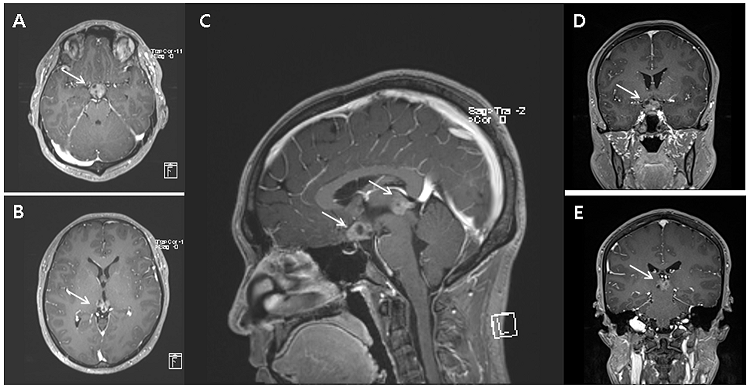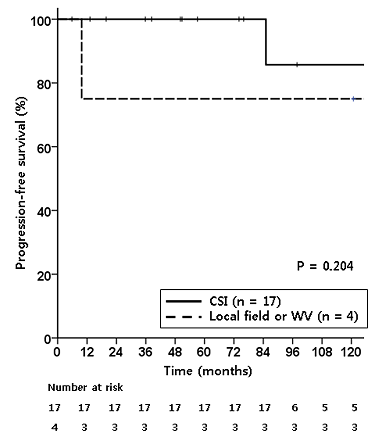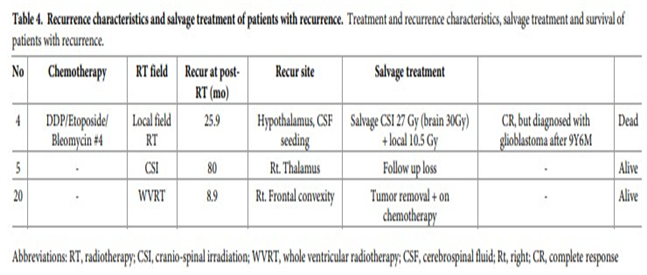글로벌 연구동향
방사선종양학
- [PLoS One.] Treatment outcomes based on radiation therapy fields for bifocal germinoma: Synchronous or disseminated disease?
연세의대 / 정승연, 윤홍인*
- 출처
- PLoS One.
- 등재일
- 2019 Oct 3
- 저널이슈번호
- 14(10):e0223481. doi: 10.1371/journal.pone.0223481. eCollection 2019.
- 내용



Abstract
Intracranial germinoma sometimes present as bifocal germinoma, and whether bifocal germinoma should be treated as a synchronous or disseminated disease remains unclear. This study aimed to determine the optimal treatment modality for bifocal germinoma. Patients with bifocal germinoma who received radiotherapy (RT) from March 1990 to August 2017 were included for analysis. A total of 21 patients were included. The median follow-up period was 76.2 months (range, 6.2-305.4 months). There were 17 patients who received cranio-spinal irradiation (CSI) with local RT; 3, whole ventricular RT (WVRT) with local RT; and 1, local RT only. Three recurrences occurred (1 patient each among those who underwent CSI, WVRT, and local RT). Recurrence in the patient who received CSI and who received WVRT occurred in the right thalamus and right frontal convexity, respectively. Meanwhile, the patient who received local RT showed not only a recurred lesion in the hypothalamus, but also cerebrospinal fluid seeding. For this patient, salvage CSI was performed and complete response was achieved after treatment. However, after 9 years and 6 months, he was diagnosed with glioblastoma and expired. As for toxicity, although 17 patients showed decrease in complete blood count levels during treatment, all patients recovered soon after treatment completion. Our findings suggest that bifocal germinoma may be considered as a disseminated disease when considering the patterns of failure according to RT fields. In addition, patients who received CSI showed low acute toxicity rates. However, further studies are necessary to confirm these findings.
Author informationChung SY1, Han JW2, Kim DS3, Yoon HI1, Suh CO4.
1
Department of Radiation Oncology, Yonsei Cancer Center, Yonsei University College of Medicine, Seoul, South Korea.
2
Department of Pediatrics, Severance Hospital, Yonsei University College of Medicine, Seoul, South Korea.
3
Department of Pediatric Neurosurgery, Severance Hospital, Yonsei University College of Medicine, Seoul, South Korea.
4
Department of Radiation Oncology, CHA Bundang Medical Center, CHA University, Seongnam-si, Gyeonggi-do, South Korea.
- 연구소개
- 현재 배아세포종에서의 방사선 치료는 단독 두개강 내 배아세포종일 경우 두개강 내만 치료하지만 파종성 배아세포종일 경우 전뇌척수 방사선 치료를 시행하고 있습니다. 그러나 배아세포종의 6-10%의 경우 두개강 내에서 이중 배아세포종, 즉 두 군데서 동시에 보이지만, 이러한 경우 어떠한 방식으로 치료할지에 대해서는 정해진 바가 없습니다. 따라서 본 연구는 이중 배아세포종 환자 21명을 대상으로 방사선 치료 범위와 재발에 대하여 분석을 하였고, 이중 배아세포종의 경우 파종성 배아세포종으로 간주하고 치료하는 것이 좋겠고, 두개척추방사선치료 (Craniospinal irradiation) 단독요법으로 치료한 경우 급성 독성도 적고, 재발율 5.9%로 치료 성적도 탁월하다고 보고하였습니다.
- 덧글달기
- 이전글 [Cancer Res Treat.] Treatment Outcome after Fractionated Conformal Radiotherapy for Hepatocellular Carcinoma in Patients with Child-Pugh Classification B in Korea (KROG 16-05).
- 다음글 [Anticancer Res.] Clinical Outcomes and the Role of Adjuvant Concurrent Chemoradiation Therapy in D2-resected LN-positive Young Patients (≤45 Years) With Gastric Cancer.









